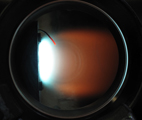Low pressure flame reactor

Aim
Flame reactors are frequently used for nanoparticle synthesis because they achieve in a straightforward manner high temperatures and large chemical yields. However, in many cases the reaction processes involved are not sufficiently understood. To investigate the chemistry related to combustion and particle formation, a premixed low-pressure flame has several advantages. Due to the mixing of the gases in ad-vance of the combustion process, a homogeneous flame perpendicular to the flow direction can be stabilized. Low pressure expands the reaction zone. Therefore, the flame can be investigated with high spatial resolution. Powerful analyzing tools such as laser spectroscopy and molecular beam sampling with mass-selective detection are combined with the low-pressure flame reactor. As a result, transient species in the flame can be analyzed and the formation and growth of particles can be studied. Furthermore, the molecular beam is also used do deposit size selected particles on substrates.
Approach
The low-pressure flame reactor consists of a water-cooled burner with horizontal flow direction mounted inside a vacuum chamber. It is fed with premixed gases. Hydrogen, acetylene, or propane serve as burner gases, while oxygen is used as an oxidizer and nitrogen or argon as diluents. The operating pressure ranges from 15 to 50 mbar. To investigate particle formation, precursors can be fed into the premixed flame gases directly or – in case of a liquid – by means of a bubbler system. The dis-tance between the burner and a probing nozzle can be adjusted to allow for prob-ing,at different positions, i.e. residence times, with a sampler/skimmer configuration. The resulting molecular beam is analyzed with a particle mass spectrometer (PMS) and a time of flight spectrometer (TOF), respectively. The measurement range is 2–15 nm for the PMS and 1–10,000 amu for the TOF. Additionally, the flame can be investigated via radial mounted optical ports enabling for laser-based techniques like laser-induced fluorescence (LIF) and laser-induced incandescence (LII).
References
P. Ifeacho, T. Huelser, H. Wiggers, C. Schulz, P. Roth, Synthesis of SnO2-x nanopar-ticles tuned between 0 < x < 1 in a premixed low pressure H2/O2/Ar flame, Proc. Combust. Inst. 31 (2007) 1805-1812.
Contact
apl. Prof. Dr. habil. H. Wiggers, Hartmut Wiggers, Tel: +49 (0)203 - 379 8087, IVG
